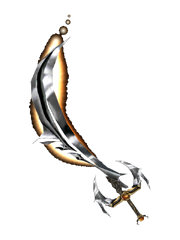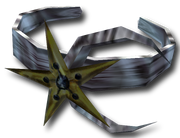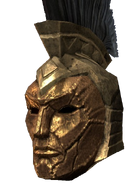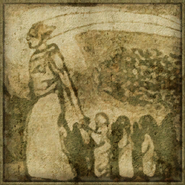Lord Indoril Nerevar, also known as Nerevar the Captain,[1] Nerevar Moon-and-Star,[2] and Godkiller;[3] was a Chimer hero who lived during the First Era. He was a champion of Azura and the first Hortator, or war-leader/champion, of the unified Chimer and Dwemer, following the overthrowing of the Nordic Empire in Resdayn. However, after the discovery that the Dwemer were creating the Numidium, he led his people against them in the War of the First Council. Nerevar died at Red Mountain, though the exact cause is disputed. Later, he became a saint of the Dunmer's Tribunal Temple.[1]
Nerevar played a crucial role in Morrowind's history. The Ashlanders and an underground offshoot of the tribunal Temple, known as the Dissident Priests of Vvardenfell, believed that he was reincarnated multiple times as part of the Nerevarine Prophecy.[2] This prophecy was fulfilled by the hero of The Elder Scrolls III: Morrowind.
Legendary origins

The Shrine of St. Nerevar
According to official Temple accounts, Nerevar was the Hortator and leader of the Chimer. Featured prominently in the negotiations for the creation of the First Council and the united kingdom of Resdayn (now known as Morrowind), he was a friend of the Dwemer leader, Dumac. However, the Chimer eventually went to war against the Dwemer (ironically, the Dwemer King would have aided Nerevar had he known what his lead scientist Kagrenac was undertaking), culminating in the Battle of Red Mountain, where Nerevar fell after the death of Dumac.
In some accounts, however, the death of Nerevar is not attributed to wounds he received during the Battle. After the Battle, Nerevar and Dagoth Ur (then known as Voryn Dagoth) proceeded into the center of the Dwemer stronghold, where they discovered the Heart of Lorkhan, as well as Kagrenac's Tools: Keening, Sunder, and Wraithguard. Nerevar commanded Dagoth Ur to guard the tools, as he went back to his advisors for instruction on what to do next. When he reached his advisors, he conferred with them for some time. They decided to leave the tools alone, and made a vow to Azura. The official account says that Nerevar went to Dagoth Ur to retrieve the tools, but Ur had been driven mad by the power of the Heart of Lorkhan in Nerevar's absence, and refused to relinquish the tools. Nerevar fought with Ur, and defeated him. Unfortunately, Nerevar was mortally wounded, and only survived long enough for his advisors to find him, and for him to make them swear to never use the tools. Unfortunately, they eventually used the tools to turn themselves into gods, and when they did, Azura appeared and cursed the entire Chimer race by "turning their eyes to fire and their skin to ash", making them into the Dunmer.
In Ashlander texts, however, Nerevar was not killed in combat, but by his three advisors, Vivec, Almalexia, and Sotha Sil. In this account, Nerevar made them swear to never use the tools, and they obeyed, but secretly conspired to murder Nerevar so that they might gain power. When attempting to summon Azura, Nerevar was foiled; Almalexia used poisoned candles and Sotha Sil used poisoned robes and Vivec used poisoned invocations. Nerevar was killed. In retribution for their betrayal, Azura turned the skin of the Chimer gray, and their eyes fiery red, making the Chimer people into what is now known as the Dunmer. However, the Tribunal (that is, Vivec, Almalexia and Sotha Sil) went on to use the power of the tools and the Heart to become immortal. Afterwards, they set themselves up as the new gods of the Dunmer, claiming superior divinity to the Daedra, whom the Chimer had self-exiled for the worship of. Eventually, their Tribunal Temple took control of all of Morrowind, becoming the monolithic and seemingly infallible entity it was by the end of the Third Era, and leaving only isolated pockets of Ashlanders to maintain the old beliefs.
Sainthood
Nerevar became a martyr and a saint of the Tribunal Temple,[1] he is also reported to have helped Baranat during his trials against the Coribael Brothers.[4] Shrines dedicated to him can be found across Vvardenfell inside temples, such as the High Fane in Vivec City, the Ghostgate Temple in the Ashlands, or the Holamayan Monastery in the Azura's Coast region.
Artifacts
During his lifetime, Nerevar made use of a number different artifacts. Some of them were obtained by the Nerevarine, the hortator's true incarnation.[2] The fate of the others is unknown.
Trueflame

Trueflame reforged
- Main article: Trueflame
After the Nordic Empire's occupation of Resdayn came to an end, Dwarf-King Dumac and Nerevar had become blood friends. On the day of Nerevar and Almalexia's wedding, Dumac presented them with powerfully enchanted twin blades, Trueflame and Hopesfire. During the Battle of Red Mountain, Trueflame was lost, its flame extinguished, and its pieces lost in the confusion.[5] A blade by the name of Trueflame may have been obtained by the Vestige in the Stonefalls in 2E 582, but it was oddly intact.[6] After Dagoth Ur's defeat in 3E 427, Almalexia tasked the Nerevarine with reforging Trueflame. With the help of Radac Stungnthumz, the blade was restored to its former glory.[2]
Moon-and-Star

- Main article: Moon-and-Star
- "The ring gave its wearer great powers of persuasion; for safety, it was enchanted to instantly kill anyone who wore it except Nerevar. The ring was called Moon-and-Star, and it helped Nerevar unite the various clans into the First Council."
- ―The Real Nerevar
One-Clan-Under-Moon-and-Star was a ring Nerevar obtained from a Dwemer smithy during the Nordic Empire's occupation of Resdayn. The Dwemer smith gave him the ring imbued with the power of persuasion, and as a safeguard, enchanted it so that anyone that wore it who was not Nerevar would instantly die. Nerevar used the ring to unite the various clans into the First Council.[7] Azura later gave the ring to the Nerevarine in the Cavern of the Incarnate.[2]
Ethos Knife
The Ethos Knife is a unique knife with little information. Vivec originally used it to murder his child City-Face.[8] Nerevar later traded his axe for the knife, and took it with him to the Battle of Red Mountain. He may have used it to kill Dumac in their duel.[9] The Knife's current whereabouts are unknown.
Nerevar's Axe
In the Temple of False Thinking of Mournhold, Nerevar chose an axe from the fight racks, and traveled to the first moon to fight empty graves, making the mistake of taking Vivec's advice literally.[10] He later traded his axe for the Ethos Knife.[9] The fate of the axe after the battle is unknown. Despite Nerevar giving it a name,[10] the true name of the axe is never mentioned.
Nerevarine
- Main article: Nerevarine
The true Nerevarine was the incarnate of Nerevar and a hero who successfully completed the Nerevarine Prophecy, saved Morrowind from the Blight and defeated Dagoth Ur.
Failed Incarnates
- Main article: Failed Incarnate
Failed Incarnates were individuals who had potential to become the true Nerevarine but failed to complete the prophecy. Known failed incarnates are:
Trivia
- According to Michael Kirkbride, the visage on each Indoril Helmet worn by Ordinators depicts the true appearance of Nerevar's face.[OOG 1]
- There was also a special Daedric helmet version based off Nerevar in the Morrowind Art Book, and Kirkbride said "its look depicted his more terrible aspect as Hortator and Padomaic champion."[OOG 1]
- The tapestry found on shrines to Nerevar depict his bonewalker. Kirkbride said that Nerevar's bonewalker was "lost to the annals of most Tribune histories. Nerevar, while betrayed or not, was still dear to ALMSIVI after death."[OOG 1]
- In The Elder Scrolls V: Skyrim, Dunmer Characters in combat can be heard praying to Nerevar.
- Nerevar is mentioned in the The Elder Scrolls Online quest "A Family Divided."
Gallery
Appearances
- The Elder Scrolls III: Morrowind (as Nerevarine)
- The Elder Scrolls III: Tribunal (as Nerevarine)
- The Elder Scrolls III: Bloodmoon (as Nerevarine)
- The Elder Scrolls IV: Oblivion (mentioned only)
- The Elder Scrolls V: Skyrim (mentioned only)
- The Elder Scrolls V: Dragonborn (mentioned only)
- The Elder Scrolls Online (mentioned only)
References
- ↑ 1.0 1.1 1.2 Lives of the Saints
- ↑ 2.0 2.1 2.2 2.3 2.4 Events of The Elder Scrolls III: Morrowind
- ↑ Varieties of Faith in the Empire
- ↑ Prayers of Baranat
- ↑ Dialogue of Almalexia in Tribunal
- ↑ Events of Online
- ↑ The Real Nerevar
- ↑ 36 Lessons of Vivec, Sermon 30
- ↑ 9.0 9.1 36 Lessons of Vivec, Sermon 36
- ↑ 10.0 10.1 36 Lessons of Vivec, Sermon 16
| Hortator of Resdayn | ||
|---|---|---|
| 1E 416 - 1E 700 | Eventually Queen Barenziah | |
| ← | → | |




